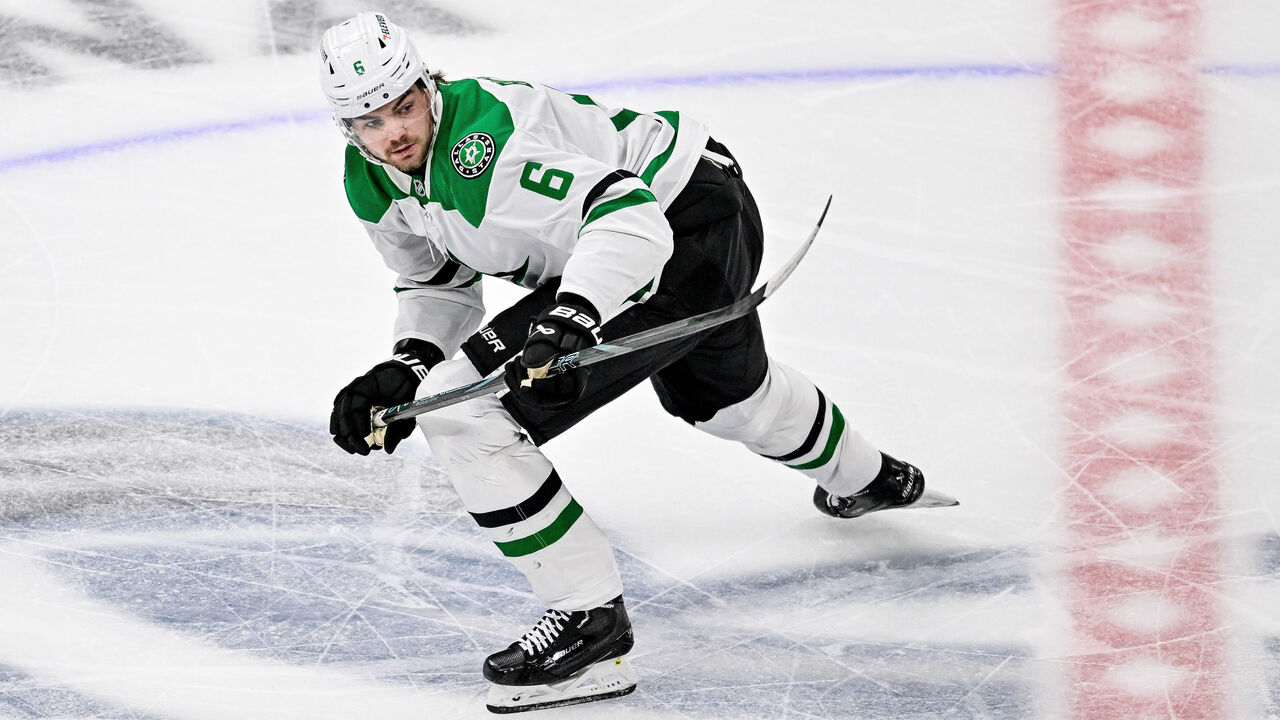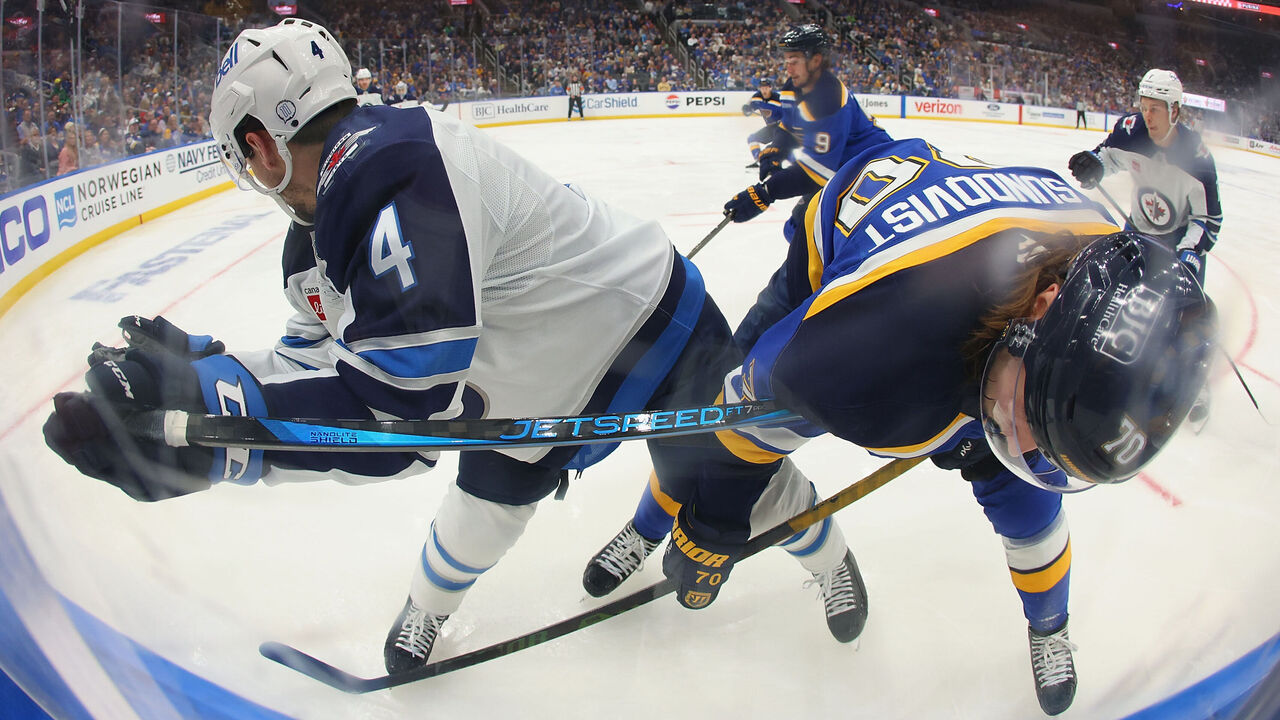Why the defensive zone retrieval is 'the hardest play in hockey'
On April 29, Vasily Podkolzin entered the offensive zone with seven minutes left in Game 5 of the Oilers-Kings playoff series. The Edmonton forward fed the puck to Viktor Arvidsson, who slapped it on net. Mattias Janmark capitalized on the rebound to put the Oilers up 2-1 in an eventual 3-1 victory.
It was a nifty sequence.
But you have to rewind 10 seconds to find the goal's true catalyst.
Jake Walman hustled to a wobbling puck in the defensive zone. The Oilers defenseman outsmarted and outmuscled a Kings forward to gain possession at the goal line. Using the net as a shield, he then skated to the hash marks on the far side of Edmonton's end and flipped the puck into the neutral zone.
In the clip, Walman retrieves a loose puck and transports it out of harm's way. The retrieval is the first step in exiting the defensive zone - an unglamorous yet supremely valuable skill in the modern NHL, especially in the forecheck-heavy playoffs and fight-for-every-inch Stanley Cup Final.
"It's not sexy, but I'd argue that's where us defensemen make a living," Golden Knights blue-liner Nicolas Hague said in an interview late in the regular season. "You want to get the puck moving that way as quickly as possible," he added while pointing north. "That's the job, really, at the end of the day."

Part of what makes retrieving a puck in the defensive zone valuable is the high degree of difficulty. No two retrievals are exactly the same because the conditions - time and score of the game, forechecking pressure, state and location of the puck, and so on - differ each time. Defensemen are tasked with solving the unique problem in front of them through a series of split-second decisions.
"Probably the hardest thing for us D-men to do," Panthers top-pair guy Gustav Forsling said. Bowen Byram of Buffalo's top four went a step further: "Probably the hardest play in hockey other than scoring goals," he said.
"When I was going from junior to pro, trying to make the NHL as a young guy, that was something coaches really worked on with me," Winnipeg's Josh Morrissey, 30, said. "I got sent back to junior as a teenager, and the message was, 'Work on your breakouts. Work on your puck retrievals.'"
With insights from nine NHLers, plus AHL defenseman-turned-private-skills-coach Jordan Hill, let's dig into the various layers of defensive zone retrievals.
Layer 1: Scan and pivot

Picture this: A defenseman is skating backwards in the neutral zone and an attacking player dumps the puck behind him. The next 1-2 seconds are dedicated to gathering information so he can plot out the next 5-10 seconds.
"There's so many things that need to go through your brain," said Hill, who works for Adam Oates' player development company. Morrissey, Buffalo's Rasmus Dahlin, and Vegas' Shea Theodore are among Oates Sports Group's many star-caliber clients.
If time allows, the defenseman needs to assess the pieces on the chessboard before hunting down the loose puck. Where's the first forechecker? How aggressively is he entering the zone? Second forechecker? Defense partner?
"You're trying to figure out where the other team's pressure is coming from, and what that looks like, and where your support is and isn't," Byram said.
Next is the pivot. The defenseman must smoothly transition from backward to forward skating, identify the exact location of the puck, and chase it at the correct angle. His back to the play now, the D-man shoulder checks like a driver scanning his blind spot on the road to assess his surroundings again. "Do it quickly and see if anything's changed," Colorado's Ryan Lindgren said.

In the above screenshot, Toronto's Chris Tanev is scanning while also closing in on the puck. Partner Jake McCabe is calling for a behind-the-net pass. The retrieval is then executed to perfection. Tanev backhands the puck to McCabe as the forechecker drills him into the end boards. McCabe moves it north, and six seconds later the Maple Leafs score off the rush against the Panthers.
"It makes your life a lot easier if the goalie or your partner talks a lot," Forsling said of callouts such as "Time!", "Wheel!", "Rim!", "Over!", and "Reverse!"
Occasionally, the callout comes from a curious source - a forechecker disguising himself as the defenseman's teammate. It's a sketchy move, and according to Forsling, it happens more often in the amateur ranks. But there's nothing illegal about verbal trickery. Defensemen are welcome to mess with rival forwards, too. Lindgren calls this dynamic "the game within the game."
"Everything is happening so quickly in those situations. You hear someone yell at you really quickly to reverse the puck, and that might fool you," Lindgren said. "You don't have the time to think, right? That said, you do get used to your partner, used to the sound of their voice, and used to how they operate."
Layer 2: Deceive and approach

A retrieval, like most aspects of hockey in 2025, is helped by deception. After all, Hill said, the blue-liner's "playing the forechecker first, the puck second."
Deception can be a standard head or shoulder fake. Or a stick wag, where the defenseman makes it appear as if he's scooping the puck up on his backhand but switches to his forehand at the last moment. Or edgework, where the toes of his skates are pointed in one direction, but he ultimately goes the other way.
"You're just trying to give false info out there," is how Dahlin summed up his take on retrievals. "You want to draw more than one player to you," the Sabres captain added, "so that you open up more space for your teammates."
Analytics company Sportlogiq doesn't specifically track retrievals. However, its "defensive zone dump-in recoveries" metric is a good proxy. Dahlin, whose blend of hockey IQ, effortless skating, puck skills, and strength is perfectly suited for retrievals, ranked third in the regular season in dump-in recoveries per game among 222 defensemen who logged 500 or more minutes.
The leaderboard is filled with well-known but underappreciated D-men:
The forecheck's main objective on a dump-in is to disrupt the defenseman's plan and either force a turnover or trap the puck in the opposing team's end. Forecheckers come in two archetypes: physical bruiser and skilled strategist.
"I personally like it when forecheckers want to hit me because you know what's coming and you can prepare yourself for it," Vegas' Noah Hanifin said. "If you have (cerebral winger) Mitch Marner chasing you down, for example, you're going to be more cautious about making a reverse play to your partner because you know he's going to cheat on it and maybe intercept the pass."
"If you're up against a small, skilled guy - a slippery guy - you know he's probably not going to hit you," Buffalo's Connor Clifton said. "But what's he going to do instead, right? Which way is he going? Is he going to get the puck off you? Angle you somewhere you don't want to go? It's just a harder read."
Some physical forecheckers ironically give the defenseman an easy out by not targeting the puck. As the clip below illustrates, defensemen - in this case, Carolina's Sean Walker - will happily take a hit (or two) to advance the puck.
Physical or skilled? Edmonton's Walman is conflicted on the topic.
"When there's a physical guy coming down, you don't have as much time. He's got one job, and he's only thinking about that. I might want the skilled guy more because then I have more room to do something," he said in March. "At the same time, you have to be really careful. The skilled guys can almost read what you're going to do and pick you off. They're both challenging. I honestly don't know which is harder or easier. It depends on the situation."
As for spacing, a defenseman ideally approaches the loose puck with the forechecker just a foot, not several feet, behind him. Deceptive movements are more easily detectable far away, so you want the forechecker on your hip, Hill said. In other words, a tight gap lets the D-man control the mini battle.
Layer 3: Settle and act

The state of the puck is arguably the biggest variable. If it's flat, traveling at a slow speed, and headed towards the end boards, the level of difficulty is relatively low. If it's spinning, traveling quickly, and about to ricochet off the boards, the defenseman - suddenly boxed into the corner - is on high alert.
"If it's stuck there and you're having to fish for it?" Walman asked rhetorically, his eyebrows raised. "That's just another thing you have to worry about."
Oates Sports Group will analyze a defenseman's stick to ensure it's built for retrievals. For instance, a blade with a curved toe and flat heel can be helpful for settling pucks deep in the zone and along the wall. Hill coaches his clients to make a smothering first touch to knock the spin off. This aggressive technique also allows the defenseman to get his head up as soon as possible.
"We're really big on concussion prevention," Hill said. "That relates back to how important it is to take the right angle and take that first touch seriously."

The ideal sequence of events, based on interviews for this story, goes something like this: defenseman scoops up the puck with speed and a forechecker in his hip pocket, wheels around the net, then either skates the puck out of the zone himself or completes a clean pass to a teammate.
"Forecheckers are like rats chasing cheese," Hill said, and gaining the net puts a barrier between rodent and food. The defenseman can beat the forechecker to the far side, make a tight turn, and skate down the middle lane.
Less exciting retrieval options include "eating it" (jamming the puck against the boards to avoid disaster), reversing it behind the net, flipping it into the neutral zone, and making a "dink" play. That last option is what Brett Kulak of the Oilers pulls off in the clip below, despite being under immense pressure.
"A lot of times it's a 2-foot pass, a little dink," Hague said. "The puck beats one guy, off you go. That's what you try to do: beat one guy, go from there."
A defenseman wants to simultaneously be unpredictable to opponents and predictable to teammates. There's a straightforwardness to retrievals within teams - two to three different options so every player is on the same page.
"Generally, the first move that comes to mind is the best play. Everybody's going to be reading off of you," Walman said. "It's good to be decisive."
Easier said than done. A retrieval is layer after layer of uncertainty.
"You have to fight fear at times. You have to fight the puck at times. You have to fight your decision-making process at times. There's a lot you're fighting with to get that puck to your forwards so they can generate offense," Hill said.
"That's why it's the hardest play in hockey."
John Matisz is theScore's senior NHL writer. Follow John on Twitter (@MatiszJohn) or contact him via email ([email protected]).
HEADLINES
- Rantanen automatically suspended 1 game after boarding Coronato
- Romanov to have shoulder surgery, out 5-6 months after Rantanen hit
- Texier signs 1-year deal with Habs after terminating Blues contract
- Best and worst offseason acquisitions at NHL quarter mark
- Nylander: Maple Leafs' skid will be 'good for our group'